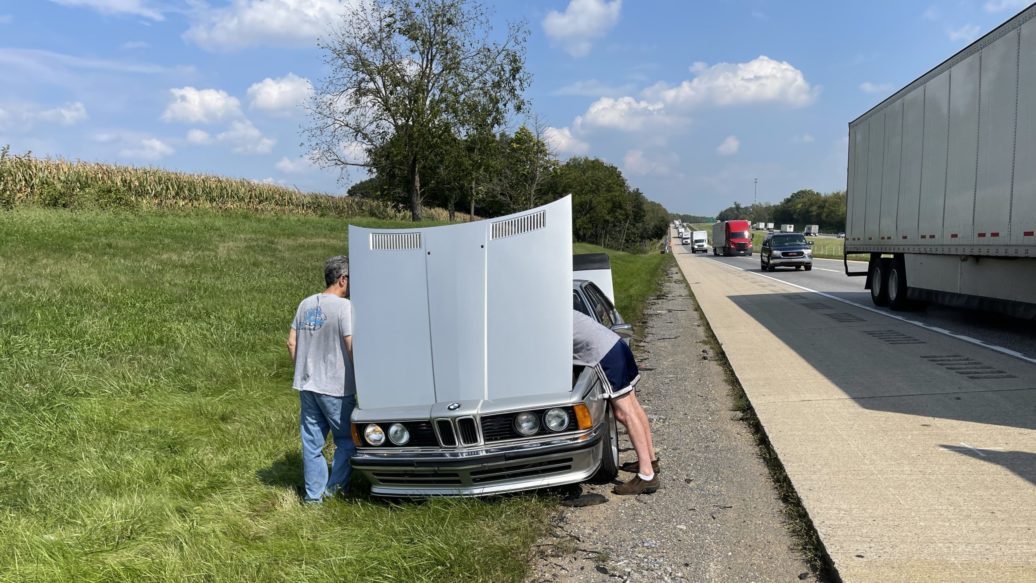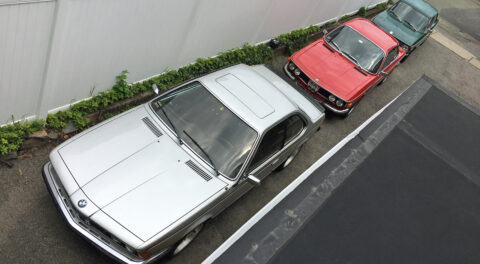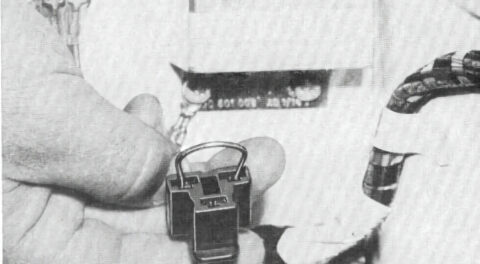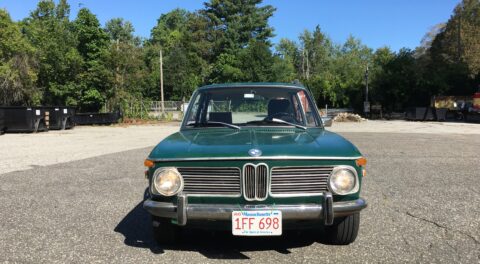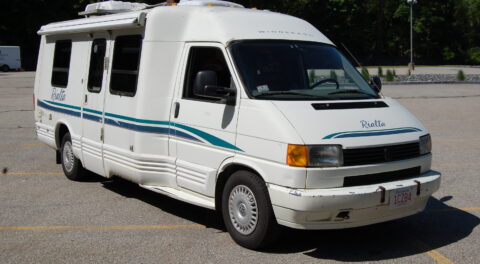Remember last week when I swapped instrument clusters in the ’79 Euro 635CSi in order to get a correctly functioning temperature gauge (the one in the car was spiking into the red, making it impossible to tell the actual temperature), drove the car 350 miles up to Vermont and back, cajoled a balky a/c fan resistor into working, and decreed that the car was ready to make the 2,000 mile round trip to the Vintage?
Well, funny story….
Prior to driving to Vermont, I had Sharkie up on the mid-rise lift in order to, as Austin Powers would say, give the undercarriage a bit of a how’s-your father. While there, I checked out the rubber gas lines at the back of the car, and noticed that the fat 12-by-18-mm line connecting the tank to the inlet side of the pump was a bit soft, and probably original to the car. The other rubber lines connecting the pump, the expansion canister, and the filter were a mish-mash of BMW and aftermarket hoses, as were the clamps—a sure sign that I hadn’t systematically replaced them all. None of the other hoses seemed soft, but clearly I hadn’t performed any preventive maintenance back here, so I ordered a meter of the 12-by-18-mm hose, two meters of the smaller 8-by-13-mm hose, a fuel filter, and a fuel pump. My plan was actually not to install the fuel pump and instead to keep it as a road spare for Sharkie, the 2002tii, and the 3.0CSi.
When I had returned from Vermont and the hoses had arrived, I put the car back up on the lift. Then I remembered something I’d forgotten, which was that the thick 12-by-18-mm hose is a pain to deal with. It goes through a channel in the body where there’s very little clearance. It’s not bad to pull the old one out, but it’s a bear to get a new one in. So I squeezed it again, and thought, “You know, it’s not that bad.”
But as a lovely river of laziness and denial began to wash gently over me, I saw something I couldn’t avoid: There was a section of the hose that had serious abrasion. It was cut through the outer rubber and into the cloth braid. And the odd thing was that it wasn’t at all clear what had caused it; it wasn’t near a rotating axle or any other component against which it could’ve rubbed. Suddenly “It’s not that bad” turned into “Well, I know what I’m doing for the next two hours.”
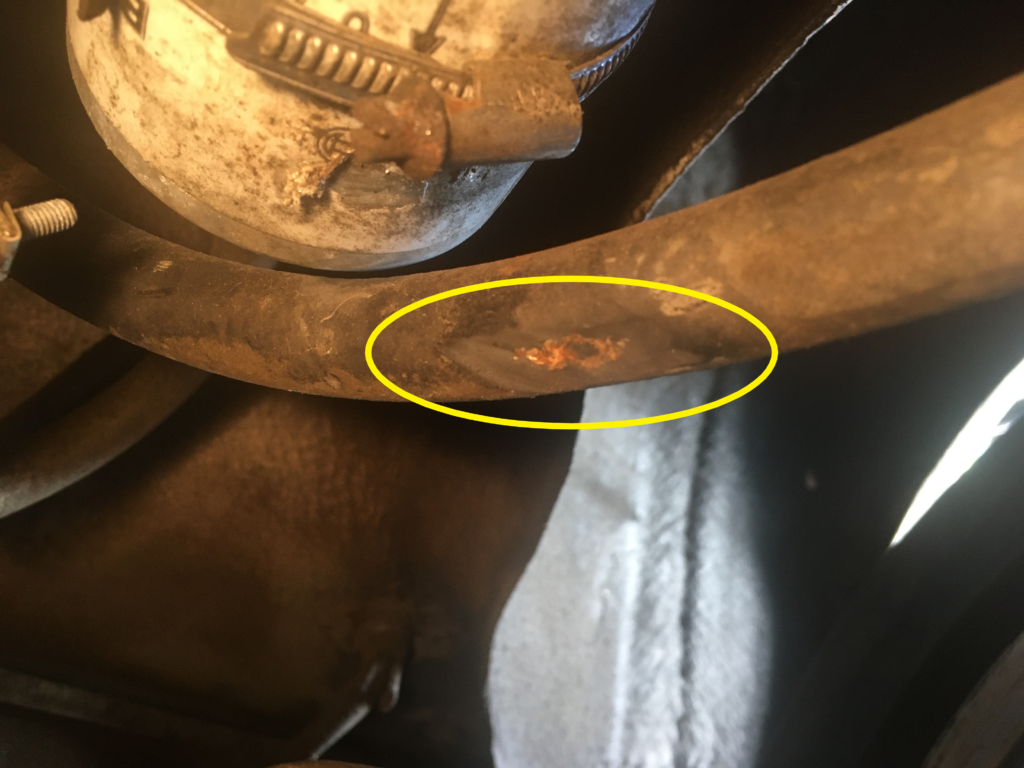
Yeesh!
I pulled the old fuel line out, and with it lying on the floor, I could see that the wear actually continued into the third-innermost layer of rubber. Scary, right?
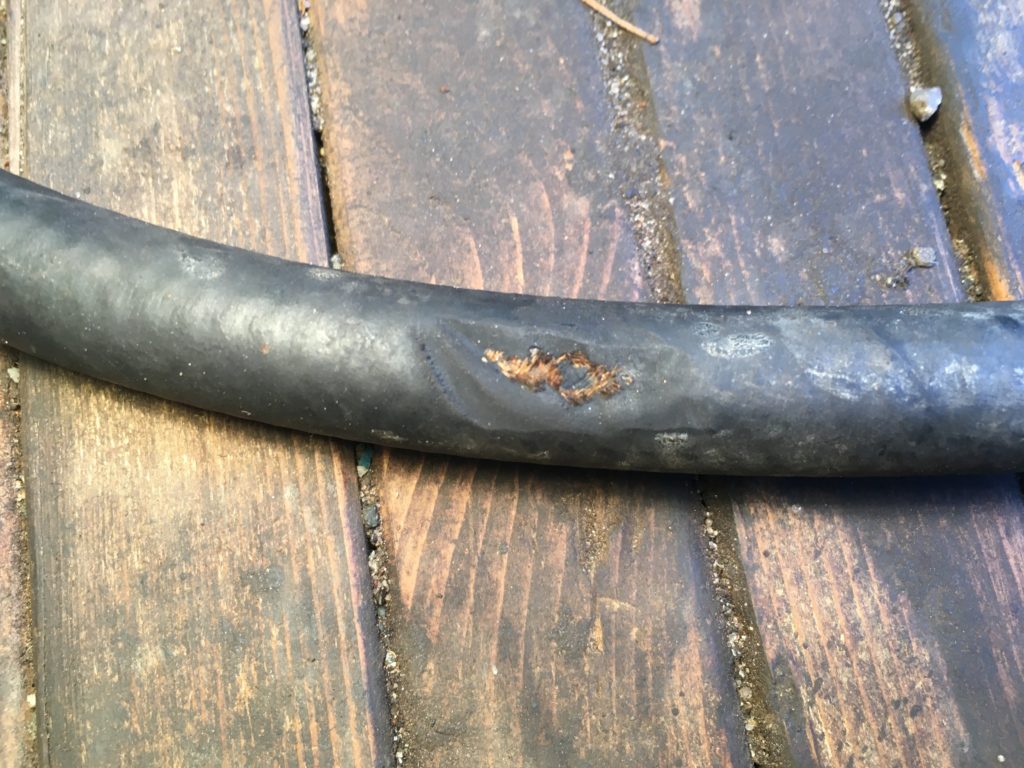
Even more yeesh-worthy in closeup.
I changed all of the 8-by-13-mm hoses and the fuel filter. I nearly installed my bought-as-a-spare fuel pump, as it would never have been easier to do it than right then, but I decided to stay on-plan and keep it as a spare for several cars. I admired my handiwork, then turned my gaze to the engine compartment.
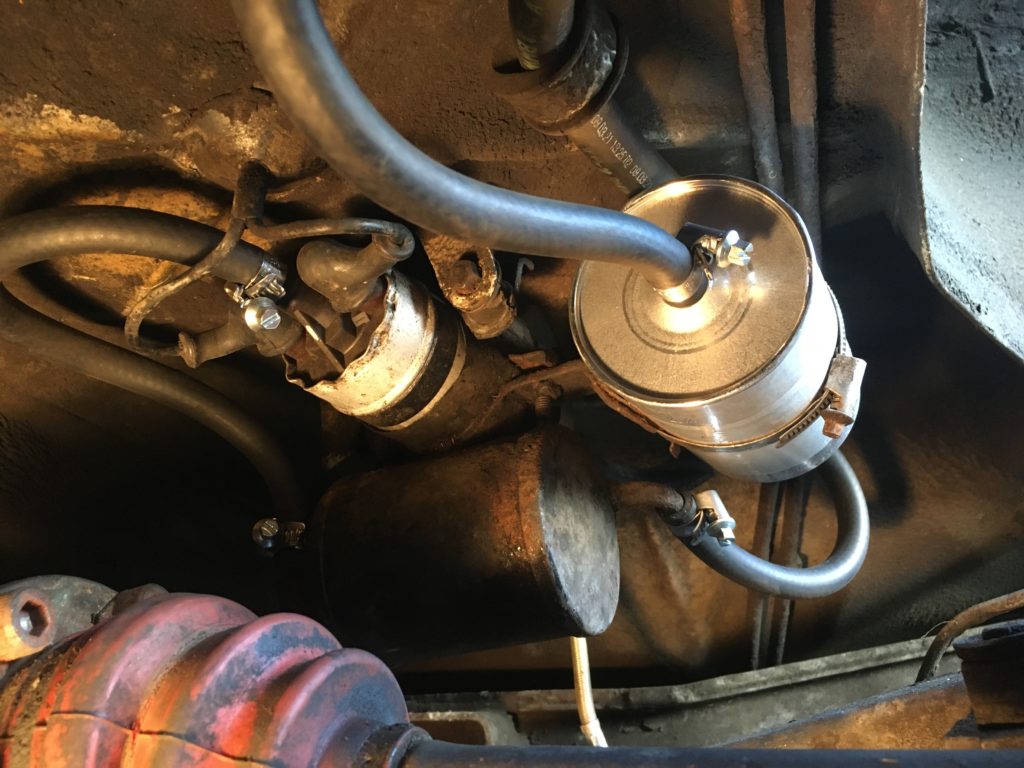
Much better.
I then moved on to checking the hoses at the front of the car. The 8-by-13-mm fuel hoses were all recent BMW-branded rubber with proper hose clamps. I had no recollection of replacing them myself, but good is good. Most of the cooling system had been replaced in 2018, but I gave the hoses a cursory look and squeeze.
I almost checked off the “looked at hoses” box when I realized that all I’d eyeballed, squeezed, and tugged were the big hoses in the front of the engine. Granted, these are the ones that get most of the heat, oil, and air, but they’re certainly not the only the only coolant hoses, and this car does have nearly 220,000 miles on it.
Then I looked at the heater hoses, and nearly gasped. They were bulging over their clamps like a fat man’s belly over his belt, and they felt as squishy as a water balloon.

The yeeshes continue.
I looked up the part numbers and checked my usual retailers, and found that the hoses appeared to be on back order from BMW. Aftermarket hoses (CRP brand) did seem to be available, but this was Monday, I was leaving Wednesday, and no one could get them to me soon enough.
I looked on eBay and found a pair of new-old-stock factory hoses, bought them just to get something in transit, and then began tearing my garage apart trying to find something that would work.
These heater hoses—one of which connects the back of the head to the heater box, the other the heater box to the pipe under the intake manifold—have asymmetrical openings; the small one is 3/4″, the larger one about 7/8″. I hunted around in the garage and found a pair of used 2002 heater hoses. They had the same-size openings, but the bends and lengths were different.
Then I had an idea. On the Vermont trip, I had noticed that even with the heater control off and the flaps shut, a fair amount of heat was coming out of the vents. I realized that the heater box is probably like my E9, in which the heater core is always on, and “turning on the heat” just opens the flap. Years ago, I fixed this on my E9 by installing a bypass valve on the heater core. I didn’t have time to do that here, but I realized that I could just use a 3/4″ barbed splicer to tie the narrow ends of both heater core hoses together. So that’s what I did.
Of course, I had to slide a catch basin under the car, since pulling off any hose dumps antifreeze, but in short order the job was done, and it solved both problems: the hoses not really fitting and the extra heat in the passenger compartment.
I then ran down to Autozone and bought some Dorman rubber caps to close off the ports to the heater core in order to keep dirt out, and took the two bulging hoses and threw them into the road-spares box, although I couldn’t imagine them being better than the ones I’d installed (he says, foreshadowing events that have not yet unfolded).
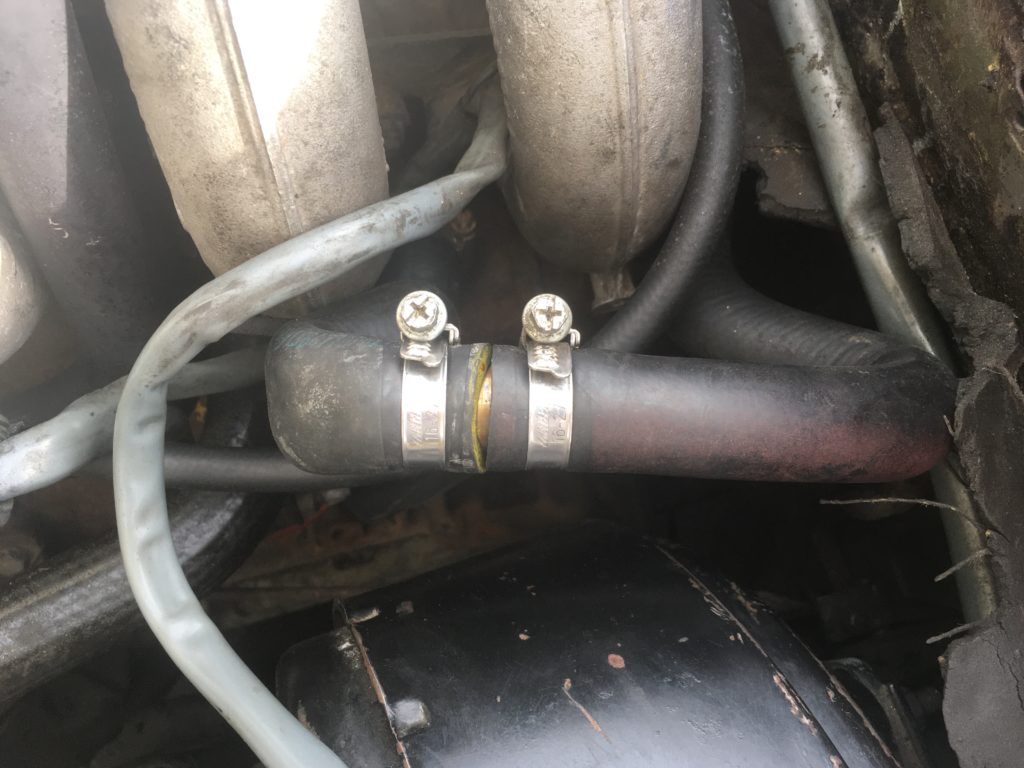
A brass barbed splicer connects the two 2002 heater hoses.
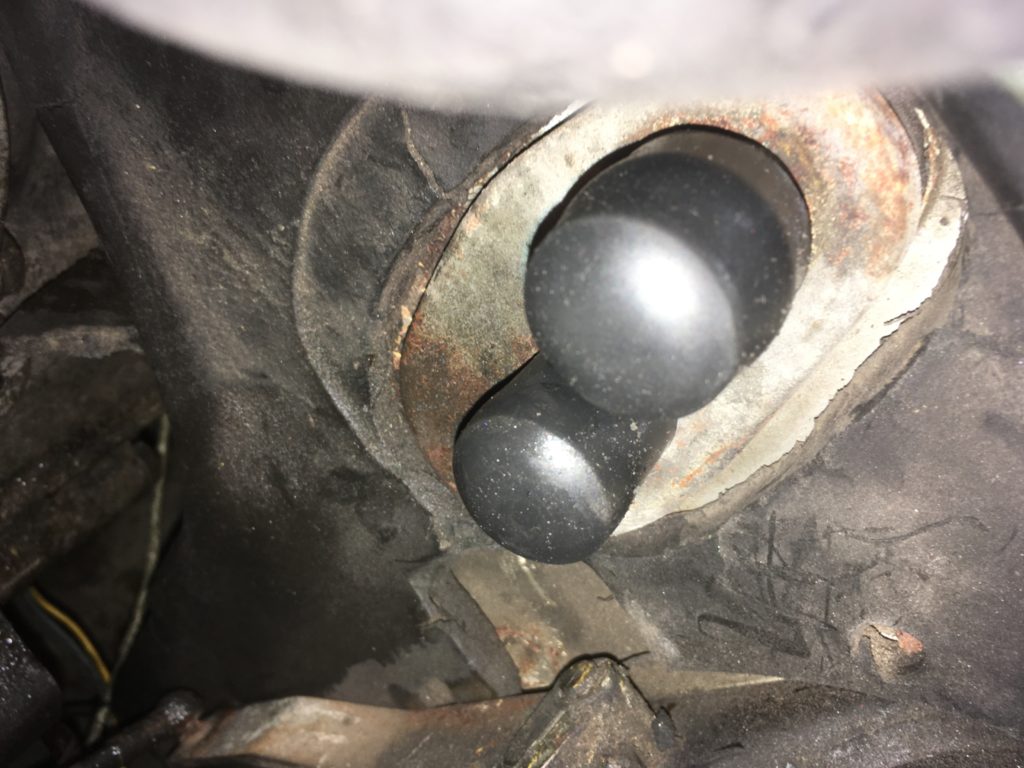
I capped the heater-core ports.
Then, the night before I left for the Vintage, I looked around the garage for other meaningful spares to take. The E24 has its original factory electronic ignition, so it doesn’t have points or a condenser, but a cap and rotor are still smart spares to carry. While poking around on the shelf where I keep the road spares for the six-cylinder cars, I was stunned to find what appeared to be two brand-new heater hoses. I probably should’ve installed them then and there, but that would mean dumping antifreeze again, so I just packed them along with the two original bulging hoses. (Da-DUM goes the foreshadowing.)
Now, on solo road trips I’ve done, I’ve not only brought a spare water pump but also two gallons of antifreeze and a catch basin, since you need those things if you’re actually going to change a water pump by the side of the road or in a parking lot. In recent years, however, I’ve realized the value of road-tripping with a caravan, since part of safety in numbers means that other people can run to the store and procure those kinds of must-have items. In fact, when I last drove Sharkie to the Vintage, the cooling fan shattered on the drive home, and my traveling posse of Andrew Wilson, Jose Rosario, and Bob Sawtelle ran to the auto-parts store and bought antifreeze and a catch basin so I could pull the radiator to get the destroyed fan out, and then Luther Brefo really saved my bacon by having a new fan and spin-on clutch, and the water pump and pulley that went with it, and the driveway in which for me to do the work.
I did throw a gallon of antifreeze in the trunk, since not doing so felt like thumbing my nose at the Automotive Powers That Be, and that’s not something you want to do.
On Wednesday morning, I met my Vintage traveling companions, Jose Rosario and Bob Sawtelle, at a service plaza on the Mass Pike. We headed out, the night’s destination the hotel-rich location of Staunton, Virginia, right on I-81. We were sailing smoothly through Pennsylvania on I-78 when the temperature in the 635CSi began slowly creeping up; I radioed to Jose and Bob that I might need to pull into a next rest area to check it out.
Bob said, “Well, it is 89 degrees out.”
I thought, Sure, combined with the fact that we’re driving 80 up and down hills, maybe that’s all I’m seeing. I was concerned, but not really alarmed. I radioed, “Let’s get past where I-78 runs into I-81.”
I didn’t make it.
The temperature continued its slow inexorable rise: 2/3 of the way up, then 3/4.
I looked for the first exit or rest area.
Then 7/8. Then one tick away from the red. This is the point where if don’t want to crack the head, you pull over.
I pulled over.
Well, more accurately, I pulled into the breakdown lane, then realized that I didn’t want to work on a car with trucks whipping past me at 70 mph. I shut the engine off, coasted as far as I could, turned the engine back on for as short a time as possible, coasted, and repeated until I found a grassy area off to the right of the breakdown lane. Bob and Jose followed suit. Convinced that it was finally safe, I got out, popped the hood, and tried to determine what was going on.
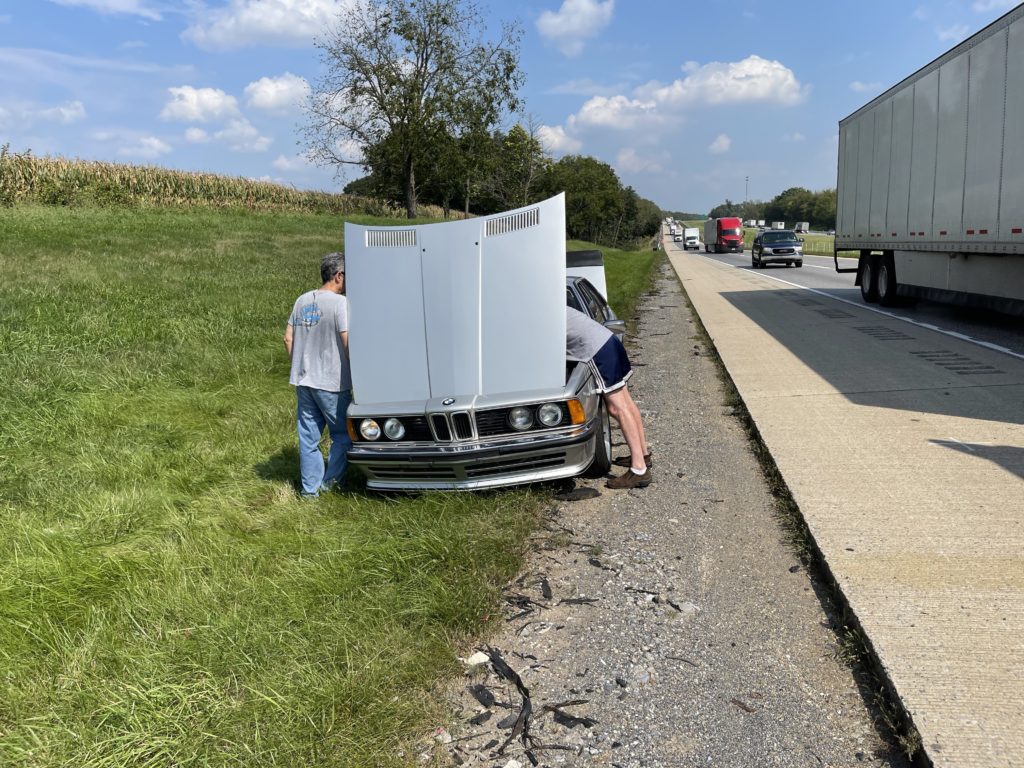
It wasn’t my preferred repair spot, but I convinced myself it was safe enough. [Photo courtesy of Bob Sawtelle.]
The source of the steam and hissing appeared to be near the metal pipe that one of the heater hoses attaches to. I thought maybe the pipe itself had cracked. As the engine cooled, the hissing abated, hindering my ability to find the source. I got the gallon of coolant out of the trunk and poured it into the expansion tank; it swallowed the entire gallon. In retrospect, this was a dumb thing to do—I didn’t need to pour in the entire gallon—but it did have the effect of rapidly producing a visible stream of coolant. It was coming from the hose itself where it connected to the metal pipe.
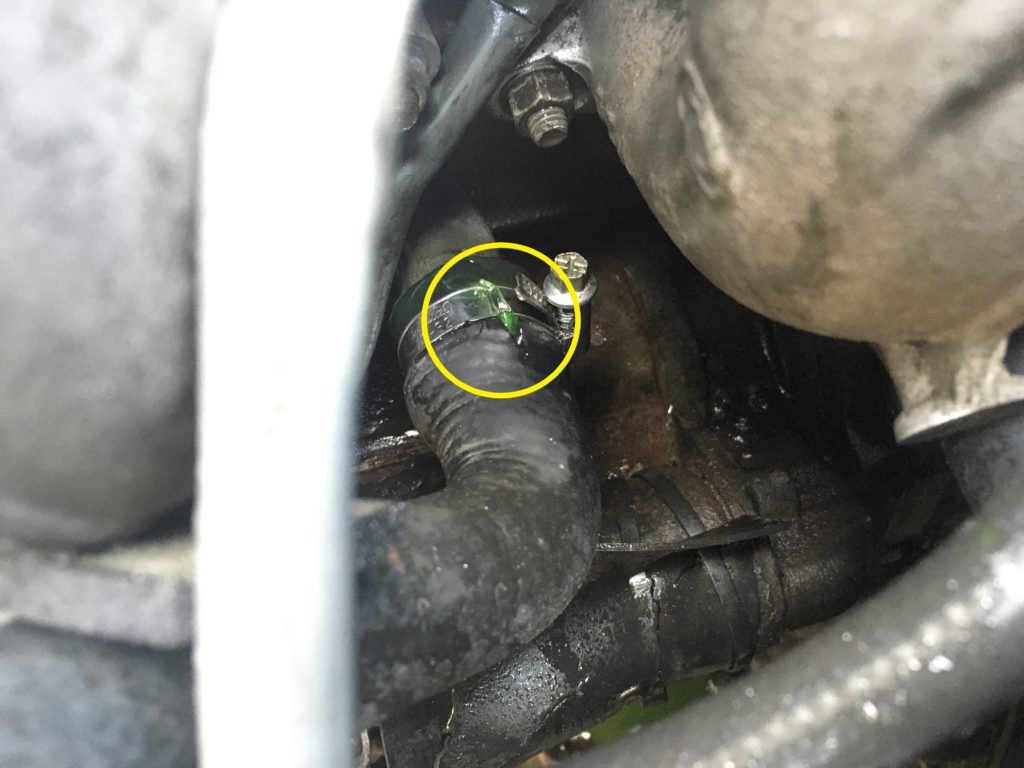
Gotcha.
Fortunately, I had not one spare hose with me, but two—the new one I’d found in my garage the night before and the original puffy one I’d pulled from the car. Obviously I went for the new one.
I was, however, out of antifreeze, since I’d only brought one gallon and had foolishly dumped the whole thing into the tank.
Bob Sawtelle went out to find two gallons of premixed antifreeze. Jose stayed with me as I replaced the hose. I thought about swapping the other hose as well, but it was the one at the back of the head, its hose clamp is difficult to get at, and I just wanted to get out of there and someplace safe as soon as possible.

If I can just get off this Pennsylvania freeway without getting killed or burned…. [Photo courtesy of Bob Sawtelle.]
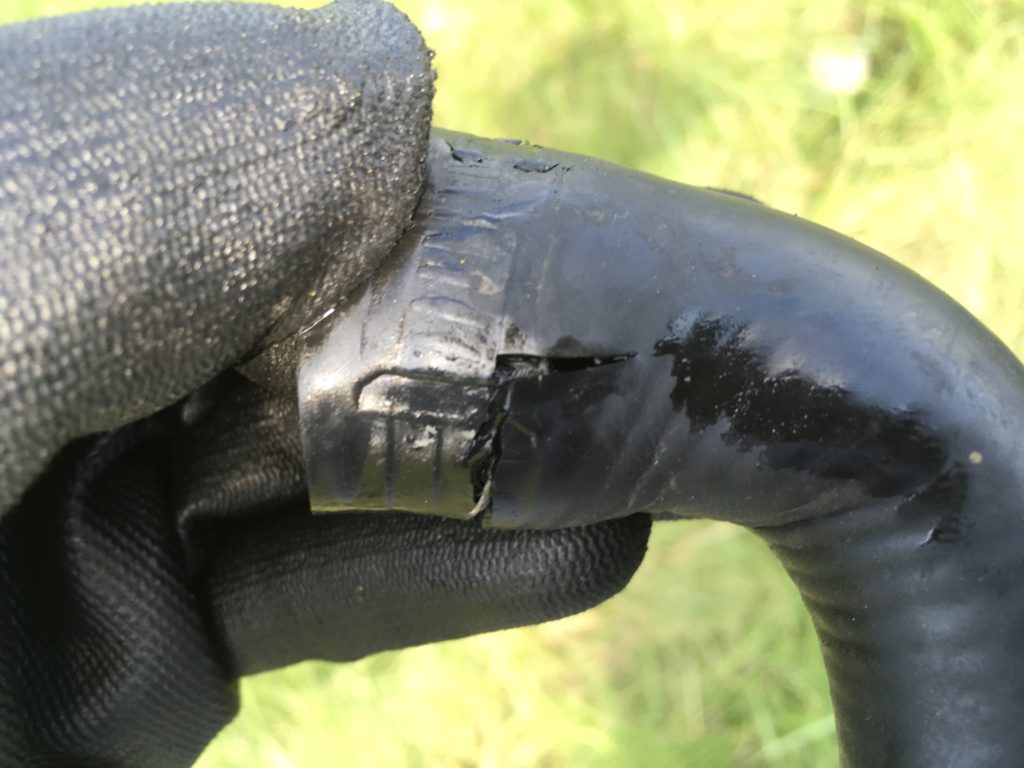
Aren’t automotive forensics fun?
Bob soon returned with two gallons of pre-mixed antifreeze, which he had to procure at a little convenience store at the Snitz Creek brewery. So I guess you could say that instead of being up Snitz Creek, I was saved by it.

Snitz Creek. Heh. [Photo courtesy of Bob Sawtelle.]
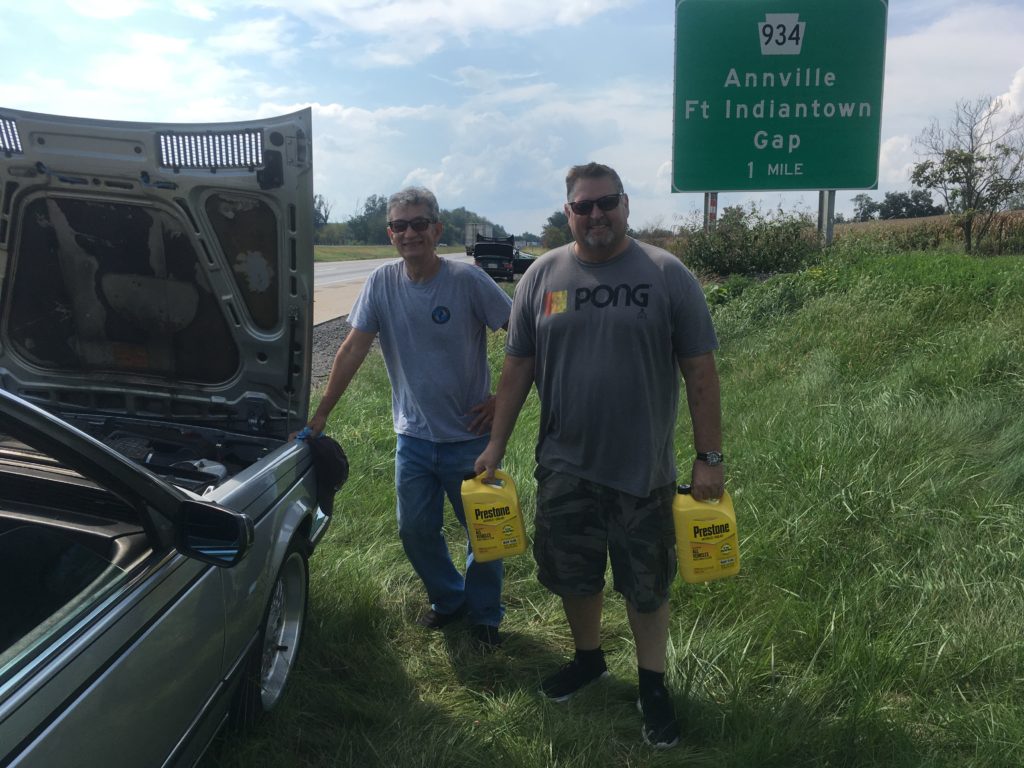
Here he comes to save the daaaaaay!
I buttoned things up, started the car, and didn’t see any further leakage. As I drove the car to the next exit, the temperature stabilized at its traditional slightly-less-than-halfway-up value. We grabbed fuel and cold drinks (I was baked). I continued to watch the gauge closely as we resumed our trip, but the car ran nice and cool all the way down to Staunton, Virginia, where we stayed Thursday night, and we made it to the host hotel for the Vintage in Asheville mid-afternoon Thursday without further incident.
So, post-mortem: Obviously, I made a mistake by not installing the never-been-used hoses that I’d found the night before I left, and in retrospect, my reasoning, in that I didn’t want to have to dump antifreeze from a car I’d just topped back up, was simply ridiculous. But I’m still puzzling over the fact that I pulled out heater hoses that were soft as raw sausage and bulging over their hose clamps, installed used ones that felt firm to the touch and on which I didn’t see any visible defects, and had one of the latter hoses fail. If I hadn’t found those new hoses, was this a swap I’d do again? I’m still not sure.
On a more big-circle-of-life note, maybe people want to travel with me because I have this reputation for being able to fix their cars if they break. I certainly have done that for folks. However, running with traveling companions works both ways: This is the second time that Bob and Jose have saved my butt. The point is that I’m just another person with a vintage car, and I am as likely to need help as I am to give it. Thanks, guys.
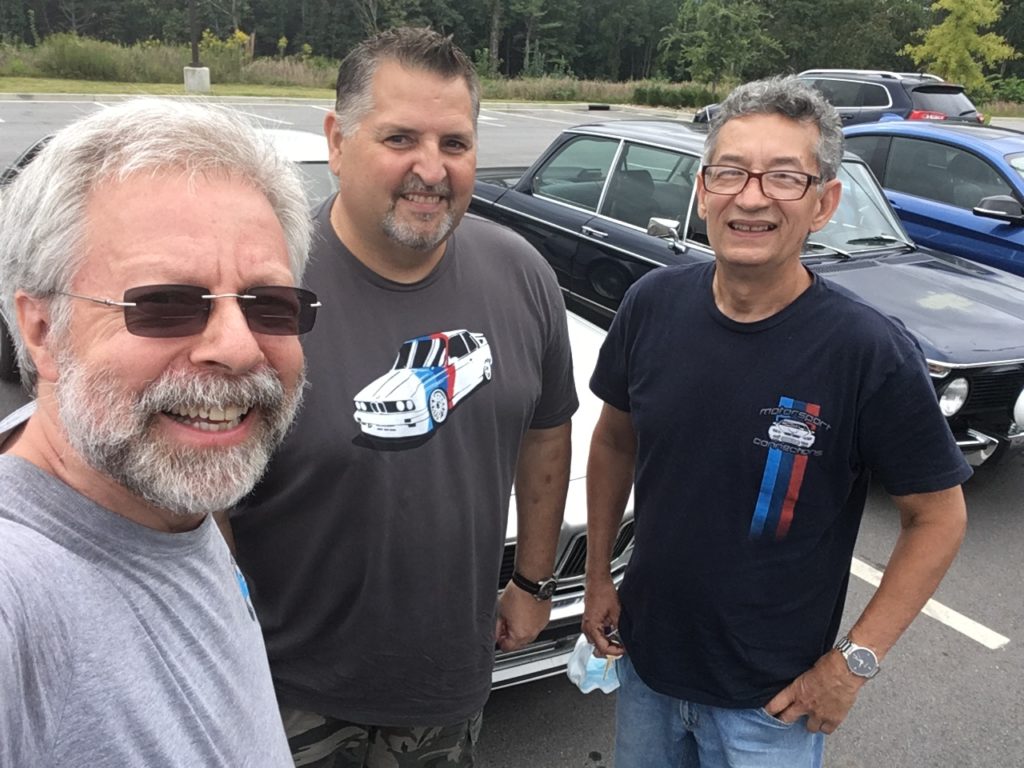
Rob’s new book, The Best of The Hack Mechanic, is available here on Amazon, as are his seven other books. Signed copies can be ordered directly from Rob here.

